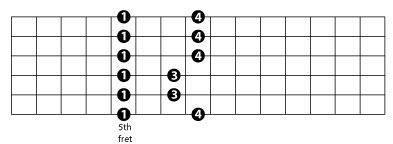If you want to learn lead guitar, solos, improvisation and riffs then you definitely want to learn how to play guitar scales.
The scale aspect quickly overwhelms many beginner guitar players because there are so many different varieties of guitar scales. Unlike learning chords, guitar scales take quite a bit of time to learn and master. In addition, guitar players really need to build up their finger strength and should do guitar finger exercises to build up strength and speed in your fingers.
- Pentatonic Scales – Pentatonic scales are the most common guitar scale to learn and this is the type that most beginners start off with. The reason why guitarists start off with this type of scale is because they are more uniform and contain fewer notes than the other scale types. This is the dominant scale used in rock and blues music. Here is a sample pentatonic guitar scale:

- Major Scale – The Major Guitar Scale is also a very common scale type and is one of the most prevalent scales in most types of music such as rock, country and folk. Songs with major chords and scales are often though of as more happy and upbeat.
- Natural Minor Scale – The Natural Minor Scale is the most common type of minor scale. There are others, but the natural minor scale is more prevalent. Unlike the major scale, the natural minor scale is more commonly associated with more sad and dramatic music. A lot of classical and modern music uses minor scales. An example would be Pink Floyd’s “Shine On You Crazy Diamond” – The song is in G minor and you can hear the chords and minor scales used throughout the song – especially in the beginning part.
- Harmonic Minor Scale – The Harmonic Minor Scale is very similar to the Natural Minor Scale. The only real difference is that it uses a raised seventh in the scale. If you want to expand more on your guitar skills such as improvisation, the Harmonic Minor Scale is a great scale type to learn.
- Melodic Minor Scale – The Melodic Minor Scale is another minor scale that is very similar to the natural and harmonic minor scales. The difference with this one is that it has a raised sixth and seventh.
As you can see, there are several different scale types for the guitar to learn. To really master scales on the guitar, you should be able to play scales on different positions on the neck. It definitely takes time, but this is the basis to learn lead guitar, improve improvisational skills and to learn better finger techniques.
